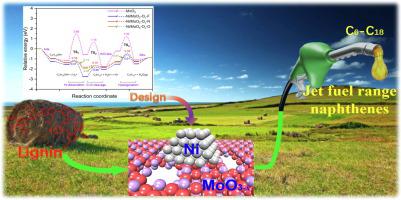Journal of Energy Chemistry ( IF 14.0 ) Pub Date : 2023-06-05 , DOI: 10.1016/j.jechem.2023.05.029 Chao Wang , Luxian Guo , Kui Wu , Xinxin Li , Yanping Huang , Zhigang Shen , Hongyun Yang , Yunquan Yang , Weiyan Wang , Changzhi Li

|
Design of a robust catalyst with high activity but the low cost for the hydrodeoxygenation (HDO) of bio–oils is of great importance to bring the biorefinery concept into reality. In this study, density functional theory (DFT) calculation was adopted to analyze the optimal location of Ni on MoO3–x containing oxygen vacancy, and the corresponding result demonstrated that metallic Ni cluster located at the neighborhood of oxygen vacancies would significantly evoke HDO activity. Enlightened by DFT results, NiMoO4 was first hydrothermally synthesized and then employed to fabricate Ni–MoO3–x catalyst via a low–temperature reduction, where Ni escaped from NiMoO4 and was reduced to its metallic state. Such an evolution of Ni species also induced the formation of oxygen vacancies around metallic Ni cluster. In the HDO of p–cresol, Ni–MoO3–x exhibited high activity with a complete conversion and a methylcyclohexane selectivity of 99.4% at 150 °C. Moreover, the catalyst showed good versatility in catalyzing HDO of diverse lignin–derived oxygenates and lignin oil. 2D HSQC NMR, gas chromatograph and elemental analysis of the lignin oil demonstrated the high deoxygenation efficiency and saturation of the benzene ring over Ni–MoO3–x. In the upgrading of crude lignin oil, the deoxygenation degree was up to 99%, and the overall carbon yield of the naphthenes was as high as 69.4%. Importantly, the structures and carbon numbers of the naphthene products are similar to jet fuel-range cycloalkanes, which are expected to have a high density that can be blended into jet fuel to raise the range (or payload) of airplanes. This work demonstrates the feasibility for improving the targeted catalytic reactivity by rational tailoring the catalyst structure under the guidance of theoretical analysis, and provides an energy-efficient route for the upgrading of lignin crude oil into valuable naphthenes.
中文翻译:

Ni-MoO3-x催化剂的合理设计,将木质素衍生的生物油高效加氢脱氧为环烷烃
设计一种具有高活性且低成本的生物油加氢脱氧(HDO)催化剂对于将生物炼制概念变为现实具有重要意义。本研究采用密度泛函理论(DFT)计算来分析Ni在含氧空位的MoO 3– x上的最佳位置,相应的结果表明位于氧空位附近的金属Ni团簇会显着激发HDO活性。受DFT结果的启发,首先水热合成NiMoO 4 ,然后通过低温还原制备Ni-MoO 3- x催化剂,其中Ni从NiMoO 4中逸出并被还原成金属状态。Ni物种的这种演化也导致了金属Ni团簇周围氧空位的形成。在对甲酚的 HDO 中,Ni-MoO 3- x表现出高活性,在 150 °C 时完全转化,甲基环己烷选择性为 99.4%。此外,该催化剂在催化多种木质素衍生含氧化合物和木质素油的 HDO 方面表现出良好的多功能性。木质素油的 2D HSQC NMR、气相色谱仪和元素分析表明 Ni–MoO 3– x具有高脱氧效率和苯环饱和度。在木质素粗油提质中,脱氧度高达99%,环烷烃总碳收率高达69.4%。重要的是,环烷烃产品的结构和碳原子数与喷气燃料范围内的环烷烃相似,预计它们具有高密度,可以混合到喷气燃料中以提高飞机的航程(或有效载荷)。该工作论证了在理论分析指导下通过合理设计催化剂结构来提高目标催化反应活性的可行性,为木质素原油升级为有价值的环烷烃提供了一条节能途径。































 京公网安备 11010802027423号
京公网安备 11010802027423号